Corporate Finance Report: Electric Motor Bike Project Analysis
VerifiedAdded on 2022/12/15
|12
|2673
|188
Report
AI Summary
This corporate finance report analyzes the financial viability of ARB Corporation's electric motor bike project. It includes a detailed discussion of financial projections, investment appraisal techniques like NPV and IRR, and the weighted average cost of capital (WACC). The report also examines the potential impact on share price, capital raising strategies, and potential sources of finance, including equity and debt financing. Furthermore, it explores shareholder wealth valuation models such as the dividend discount model, free cash flow method, and residual income valuation. The report concludes with an overview of the signalling effect of dividends and the overall financial implications of the project.
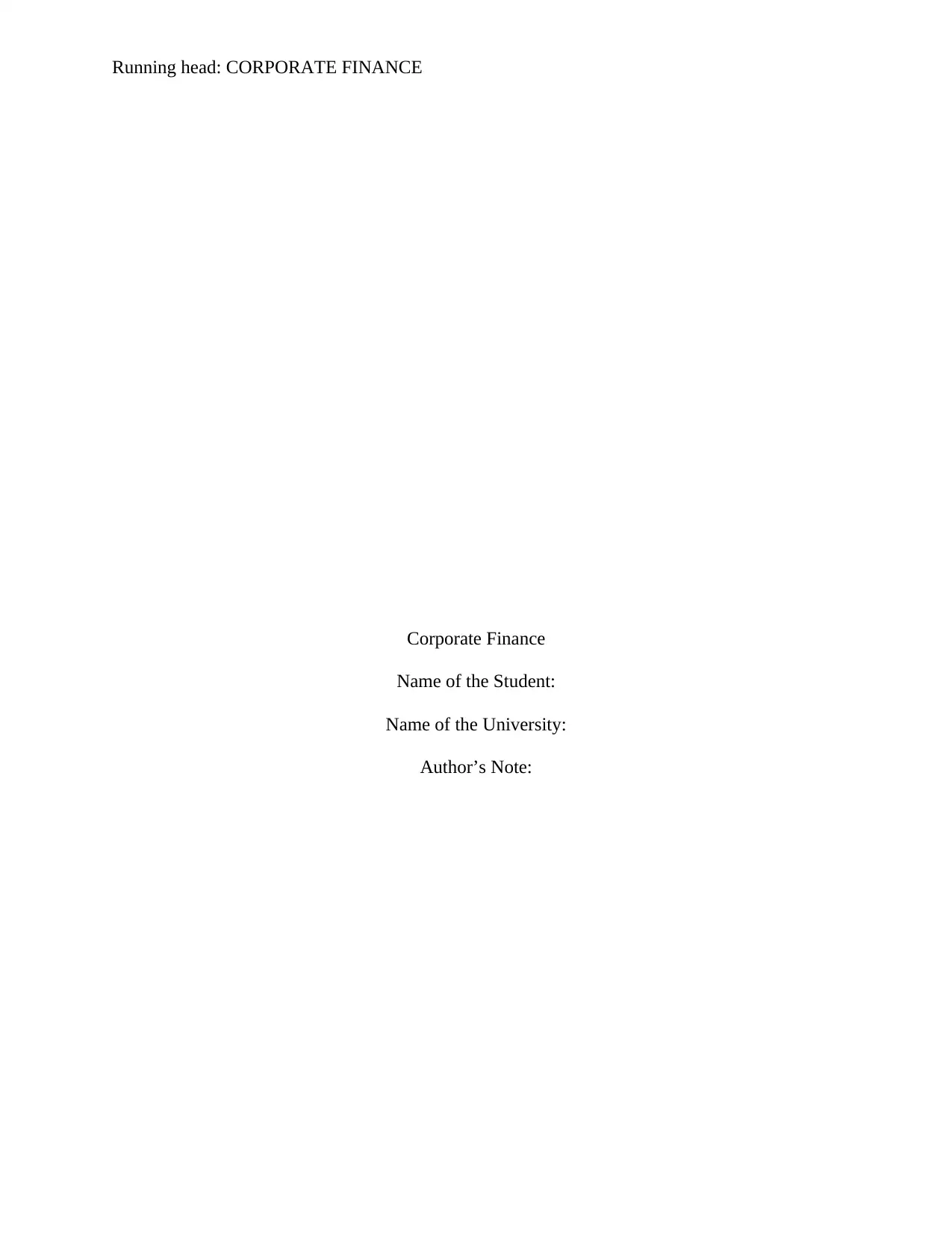
Running head: CORPORATE FINANCE
Corporate Finance
Name of the Student:
Name of the University:
Author’s Note:
Corporate Finance
Name of the Student:
Name of the University:
Author’s Note:
Paraphrase This Document
Need a fresh take? Get an instant paraphrase of this document with our AI Paraphraser
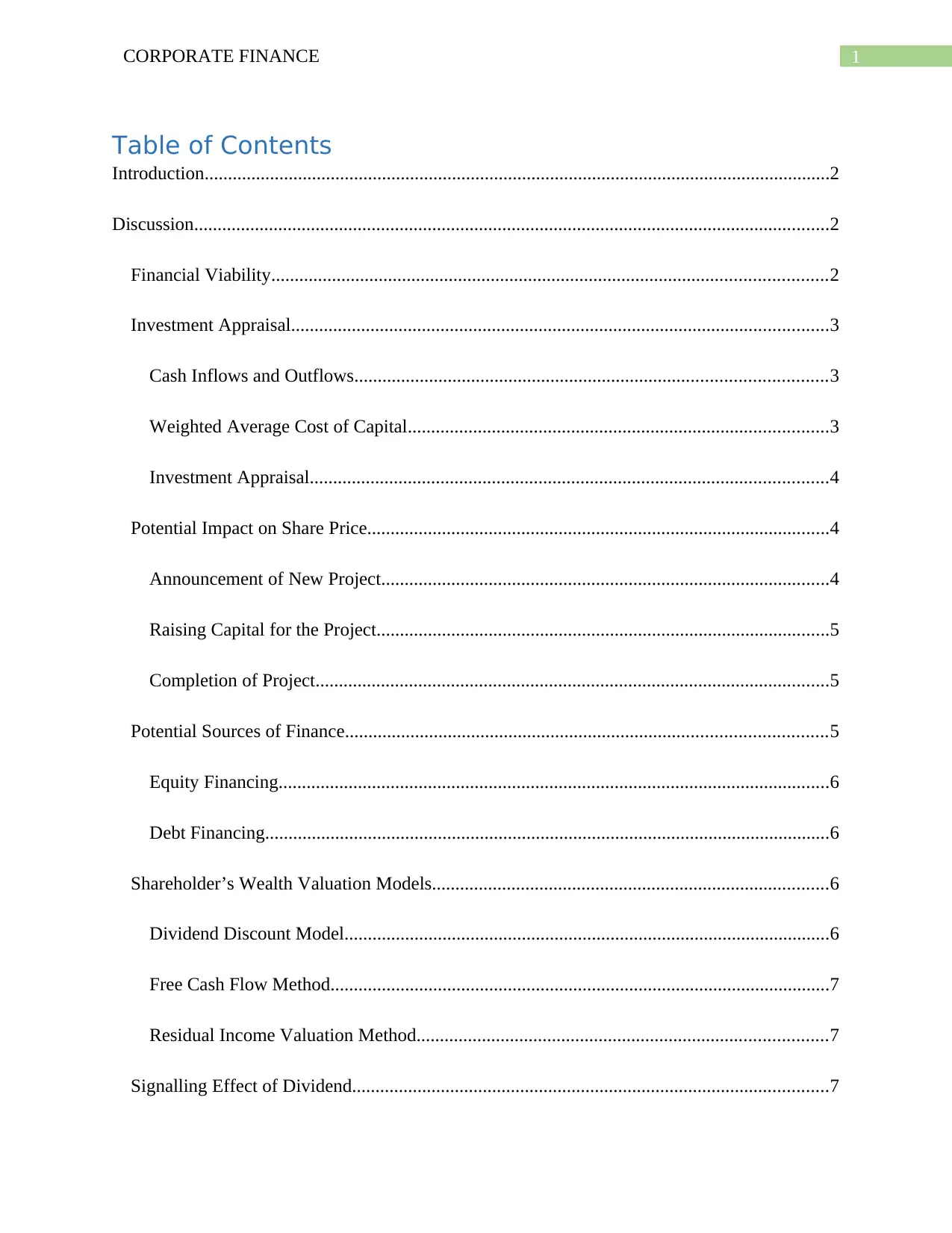
1CORPORATE FINANCE
Table of Contents
Introduction......................................................................................................................................2
Discussion........................................................................................................................................2
Financial Viability.......................................................................................................................2
Investment Appraisal...................................................................................................................3
Cash Inflows and Outflows.....................................................................................................3
Weighted Average Cost of Capital..........................................................................................3
Investment Appraisal...............................................................................................................4
Potential Impact on Share Price...................................................................................................4
Announcement of New Project................................................................................................4
Raising Capital for the Project.................................................................................................5
Completion of Project..............................................................................................................5
Potential Sources of Finance.......................................................................................................5
Equity Financing......................................................................................................................6
Debt Financing.........................................................................................................................6
Shareholder’s Wealth Valuation Models.....................................................................................6
Dividend Discount Model........................................................................................................6
Free Cash Flow Method...........................................................................................................7
Residual Income Valuation Method........................................................................................7
Signalling Effect of Dividend......................................................................................................7
Table of Contents
Introduction......................................................................................................................................2
Discussion........................................................................................................................................2
Financial Viability.......................................................................................................................2
Investment Appraisal...................................................................................................................3
Cash Inflows and Outflows.....................................................................................................3
Weighted Average Cost of Capital..........................................................................................3
Investment Appraisal...............................................................................................................4
Potential Impact on Share Price...................................................................................................4
Announcement of New Project................................................................................................4
Raising Capital for the Project.................................................................................................5
Completion of Project..............................................................................................................5
Potential Sources of Finance.......................................................................................................5
Equity Financing......................................................................................................................6
Debt Financing.........................................................................................................................6
Shareholder’s Wealth Valuation Models.....................................................................................6
Dividend Discount Model........................................................................................................6
Free Cash Flow Method...........................................................................................................7
Residual Income Valuation Method........................................................................................7
Signalling Effect of Dividend......................................................................................................7

2CORPORATE FINANCE
Conclusion.......................................................................................................................................7
References........................................................................................................................................9
Conclusion.......................................................................................................................................7
References........................................................................................................................................9
⊘ This is a preview!⊘
Do you want full access?
Subscribe today to unlock all pages.

Trusted by 1+ million students worldwide
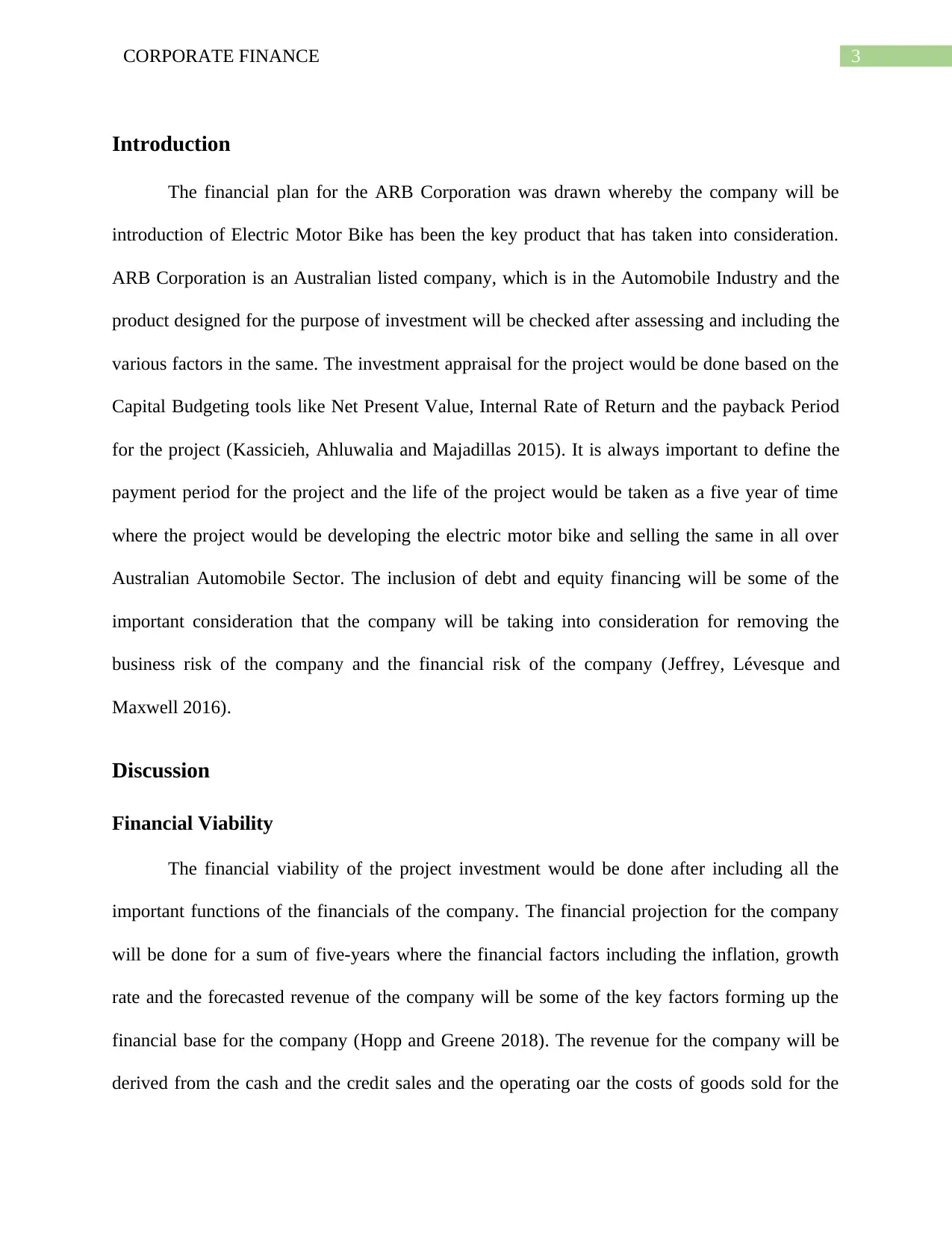
3CORPORATE FINANCE
Introduction
The financial plan for the ARB Corporation was drawn whereby the company will be
introduction of Electric Motor Bike has been the key product that has taken into consideration.
ARB Corporation is an Australian listed company, which is in the Automobile Industry and the
product designed for the purpose of investment will be checked after assessing and including the
various factors in the same. The investment appraisal for the project would be done based on the
Capital Budgeting tools like Net Present Value, Internal Rate of Return and the payback Period
for the project (Kassicieh, Ahluwalia and Majadillas 2015). It is always important to define the
payment period for the project and the life of the project would be taken as a five year of time
where the project would be developing the electric motor bike and selling the same in all over
Australian Automobile Sector. The inclusion of debt and equity financing will be some of the
important consideration that the company will be taking into consideration for removing the
business risk of the company and the financial risk of the company (Jeffrey, Lévesque and
Maxwell 2016).
Discussion
Financial Viability
The financial viability of the project investment would be done after including all the
important functions of the financials of the company. The financial projection for the company
will be done for a sum of five-years where the financial factors including the inflation, growth
rate and the forecasted revenue of the company will be some of the key factors forming up the
financial base for the company (Hopp and Greene 2018). The revenue for the company will be
derived from the cash and the credit sales and the operating oar the costs of goods sold for the
Introduction
The financial plan for the ARB Corporation was drawn whereby the company will be
introduction of Electric Motor Bike has been the key product that has taken into consideration.
ARB Corporation is an Australian listed company, which is in the Automobile Industry and the
product designed for the purpose of investment will be checked after assessing and including the
various factors in the same. The investment appraisal for the project would be done based on the
Capital Budgeting tools like Net Present Value, Internal Rate of Return and the payback Period
for the project (Kassicieh, Ahluwalia and Majadillas 2015). It is always important to define the
payment period for the project and the life of the project would be taken as a five year of time
where the project would be developing the electric motor bike and selling the same in all over
Australian Automobile Sector. The inclusion of debt and equity financing will be some of the
important consideration that the company will be taking into consideration for removing the
business risk of the company and the financial risk of the company (Jeffrey, Lévesque and
Maxwell 2016).
Discussion
Financial Viability
The financial viability of the project investment would be done after including all the
important functions of the financials of the company. The financial projection for the company
will be done for a sum of five-years where the financial factors including the inflation, growth
rate and the forecasted revenue of the company will be some of the key factors forming up the
financial base for the company (Hopp and Greene 2018). The revenue for the company will be
derived from the cash and the credit sales and the operating oar the costs of goods sold for the
Paraphrase This Document
Need a fresh take? Get an instant paraphrase of this document with our AI Paraphraser
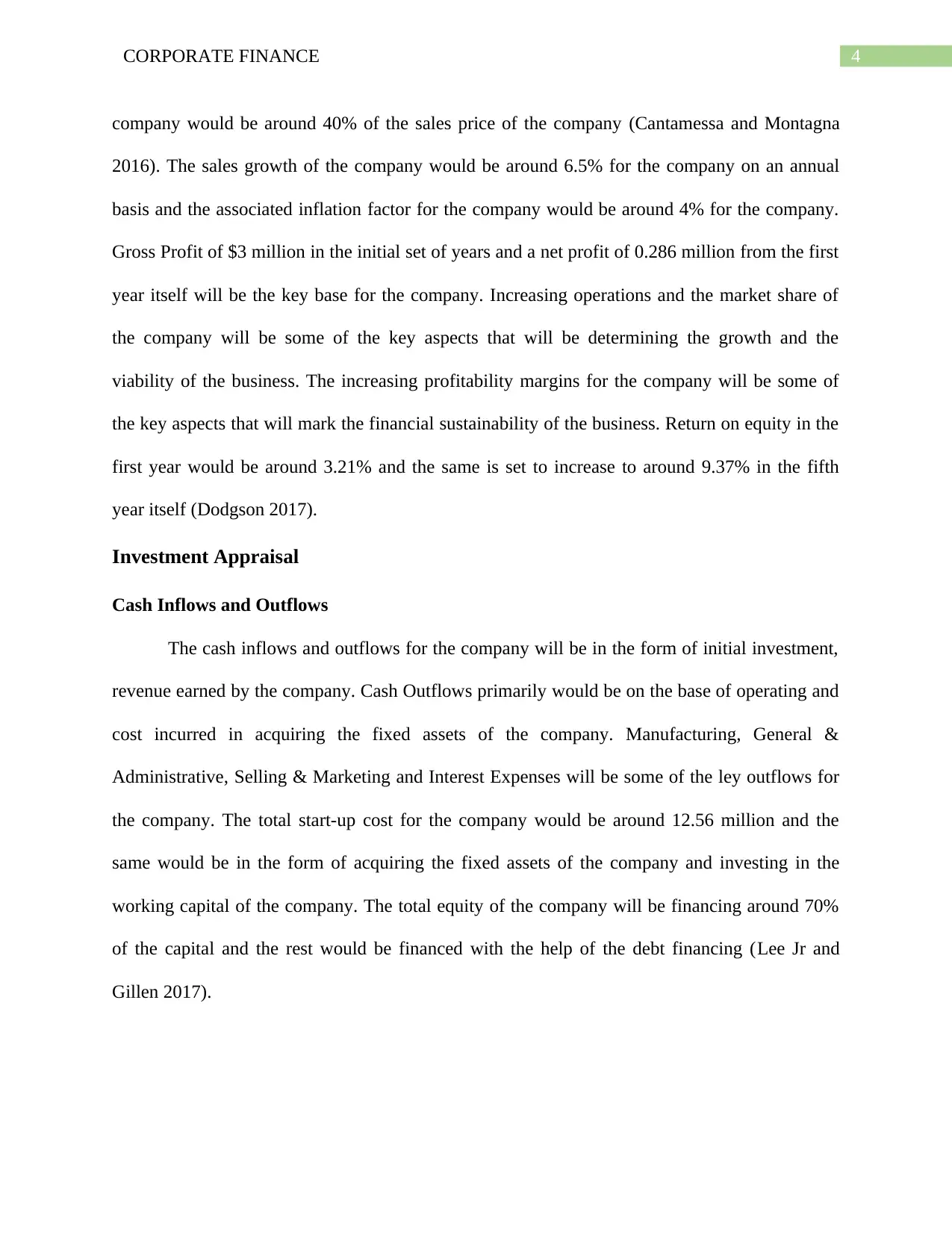
4CORPORATE FINANCE
company would be around 40% of the sales price of the company (Cantamessa and Montagna
2016). The sales growth of the company would be around 6.5% for the company on an annual
basis and the associated inflation factor for the company would be around 4% for the company.
Gross Profit of $3 million in the initial set of years and a net profit of 0.286 million from the first
year itself will be the key base for the company. Increasing operations and the market share of
the company will be some of the key aspects that will be determining the growth and the
viability of the business. The increasing profitability margins for the company will be some of
the key aspects that will mark the financial sustainability of the business. Return on equity in the
first year would be around 3.21% and the same is set to increase to around 9.37% in the fifth
year itself (Dodgson 2017).
Investment Appraisal
Cash Inflows and Outflows
The cash inflows and outflows for the company will be in the form of initial investment,
revenue earned by the company. Cash Outflows primarily would be on the base of operating and
cost incurred in acquiring the fixed assets of the company. Manufacturing, General &
Administrative, Selling & Marketing and Interest Expenses will be some of the ley outflows for
the company. The total start-up cost for the company would be around 12.56 million and the
same would be in the form of acquiring the fixed assets of the company and investing in the
working capital of the company. The total equity of the company will be financing around 70%
of the capital and the rest would be financed with the help of the debt financing (Lee Jr and
Gillen 2017).
company would be around 40% of the sales price of the company (Cantamessa and Montagna
2016). The sales growth of the company would be around 6.5% for the company on an annual
basis and the associated inflation factor for the company would be around 4% for the company.
Gross Profit of $3 million in the initial set of years and a net profit of 0.286 million from the first
year itself will be the key base for the company. Increasing operations and the market share of
the company will be some of the key aspects that will be determining the growth and the
viability of the business. The increasing profitability margins for the company will be some of
the key aspects that will mark the financial sustainability of the business. Return on equity in the
first year would be around 3.21% and the same is set to increase to around 9.37% in the fifth
year itself (Dodgson 2017).
Investment Appraisal
Cash Inflows and Outflows
The cash inflows and outflows for the company will be in the form of initial investment,
revenue earned by the company. Cash Outflows primarily would be on the base of operating and
cost incurred in acquiring the fixed assets of the company. Manufacturing, General &
Administrative, Selling & Marketing and Interest Expenses will be some of the ley outflows for
the company. The total start-up cost for the company would be around 12.56 million and the
same would be in the form of acquiring the fixed assets of the company and investing in the
working capital of the company. The total equity of the company will be financing around 70%
of the capital and the rest would be financed with the help of the debt financing (Lee Jr and
Gillen 2017).
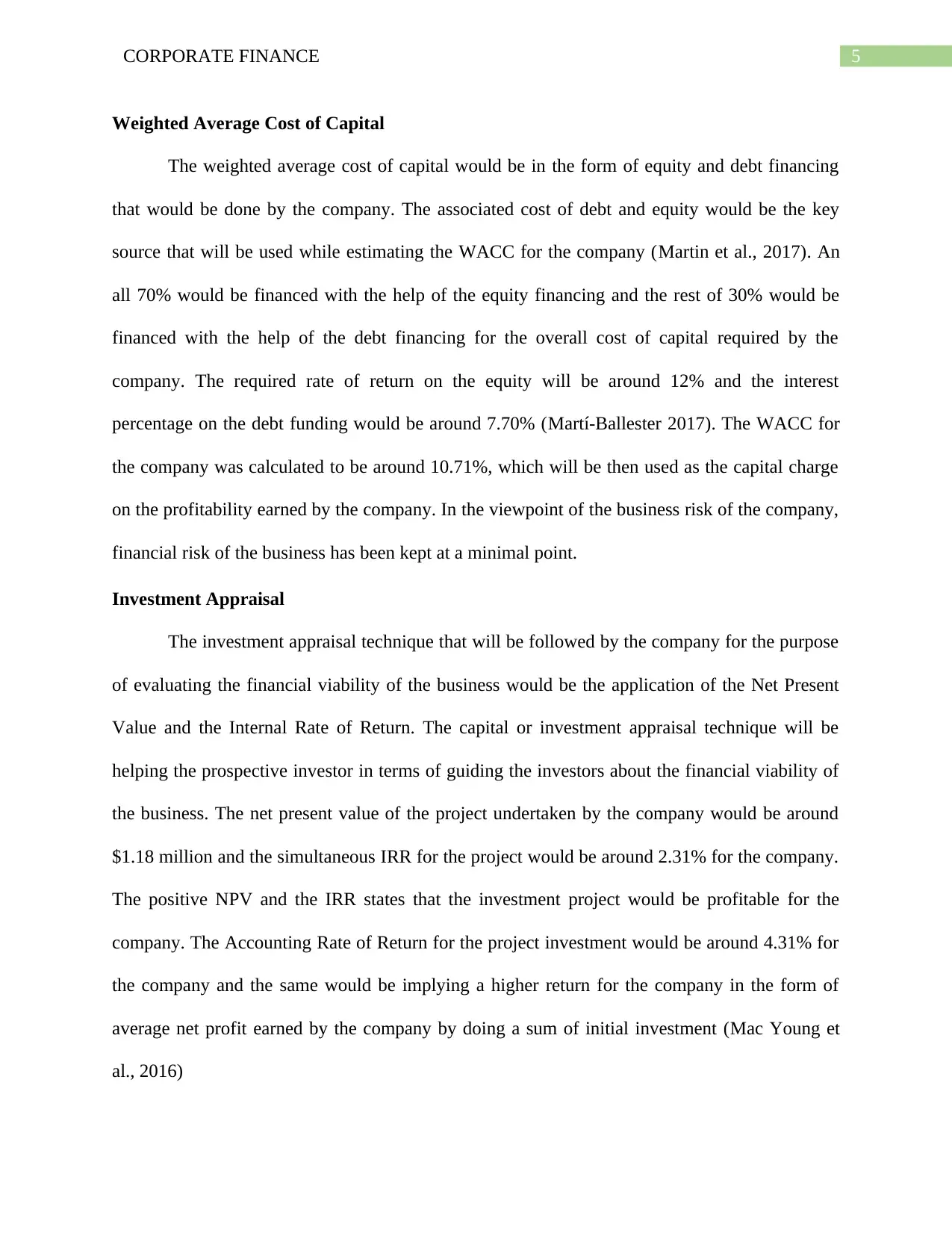
5CORPORATE FINANCE
Weighted Average Cost of Capital
The weighted average cost of capital would be in the form of equity and debt financing
that would be done by the company. The associated cost of debt and equity would be the key
source that will be used while estimating the WACC for the company (Martin et al., 2017). An
all 70% would be financed with the help of the equity financing and the rest of 30% would be
financed with the help of the debt financing for the overall cost of capital required by the
company. The required rate of return on the equity will be around 12% and the interest
percentage on the debt funding would be around 7.70% (Martí-Ballester 2017). The WACC for
the company was calculated to be around 10.71%, which will be then used as the capital charge
on the profitability earned by the company. In the viewpoint of the business risk of the company,
financial risk of the business has been kept at a minimal point.
Investment Appraisal
The investment appraisal technique that will be followed by the company for the purpose
of evaluating the financial viability of the business would be the application of the Net Present
Value and the Internal Rate of Return. The capital or investment appraisal technique will be
helping the prospective investor in terms of guiding the investors about the financial viability of
the business. The net present value of the project undertaken by the company would be around
$1.18 million and the simultaneous IRR for the project would be around 2.31% for the company.
The positive NPV and the IRR states that the investment project would be profitable for the
company. The Accounting Rate of Return for the project investment would be around 4.31% for
the company and the same would be implying a higher return for the company in the form of
average net profit earned by the company by doing a sum of initial investment (Mac Young et
al., 2016)
Weighted Average Cost of Capital
The weighted average cost of capital would be in the form of equity and debt financing
that would be done by the company. The associated cost of debt and equity would be the key
source that will be used while estimating the WACC for the company (Martin et al., 2017). An
all 70% would be financed with the help of the equity financing and the rest of 30% would be
financed with the help of the debt financing for the overall cost of capital required by the
company. The required rate of return on the equity will be around 12% and the interest
percentage on the debt funding would be around 7.70% (Martí-Ballester 2017). The WACC for
the company was calculated to be around 10.71%, which will be then used as the capital charge
on the profitability earned by the company. In the viewpoint of the business risk of the company,
financial risk of the business has been kept at a minimal point.
Investment Appraisal
The investment appraisal technique that will be followed by the company for the purpose
of evaluating the financial viability of the business would be the application of the Net Present
Value and the Internal Rate of Return. The capital or investment appraisal technique will be
helping the prospective investor in terms of guiding the investors about the financial viability of
the business. The net present value of the project undertaken by the company would be around
$1.18 million and the simultaneous IRR for the project would be around 2.31% for the company.
The positive NPV and the IRR states that the investment project would be profitable for the
company. The Accounting Rate of Return for the project investment would be around 4.31% for
the company and the same would be implying a higher return for the company in the form of
average net profit earned by the company by doing a sum of initial investment (Mac Young et
al., 2016)
⊘ This is a preview!⊘
Do you want full access?
Subscribe today to unlock all pages.

Trusted by 1+ million students worldwide
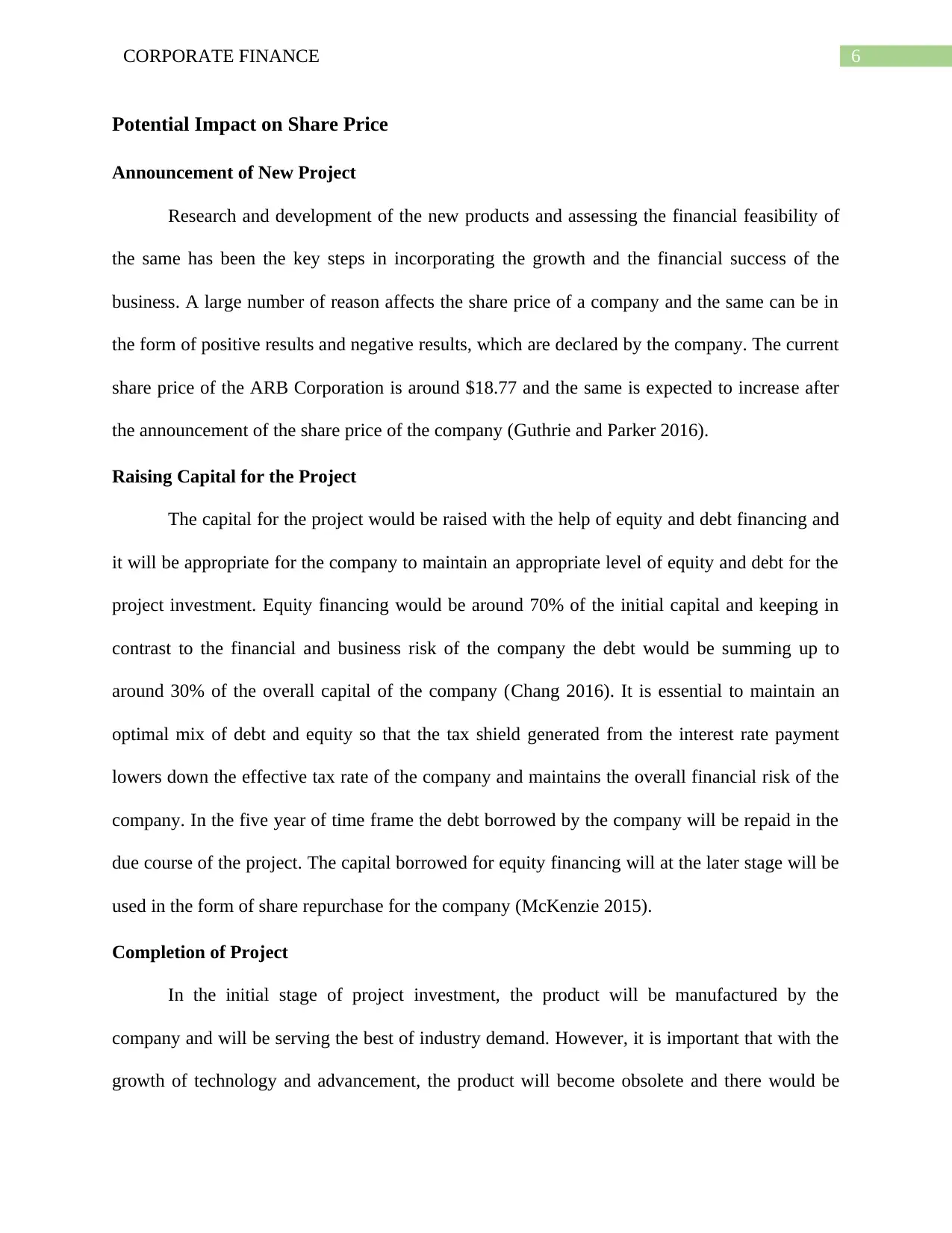
6CORPORATE FINANCE
Potential Impact on Share Price
Announcement of New Project
Research and development of the new products and assessing the financial feasibility of
the same has been the key steps in incorporating the growth and the financial success of the
business. A large number of reason affects the share price of a company and the same can be in
the form of positive results and negative results, which are declared by the company. The current
share price of the ARB Corporation is around $18.77 and the same is expected to increase after
the announcement of the share price of the company (Guthrie and Parker 2016).
Raising Capital for the Project
The capital for the project would be raised with the help of equity and debt financing and
it will be appropriate for the company to maintain an appropriate level of equity and debt for the
project investment. Equity financing would be around 70% of the initial capital and keeping in
contrast to the financial and business risk of the company the debt would be summing up to
around 30% of the overall capital of the company (Chang 2016). It is essential to maintain an
optimal mix of debt and equity so that the tax shield generated from the interest rate payment
lowers down the effective tax rate of the company and maintains the overall financial risk of the
company. In the five year of time frame the debt borrowed by the company will be repaid in the
due course of the project. The capital borrowed for equity financing will at the later stage will be
used in the form of share repurchase for the company (McKenzie 2015).
Completion of Project
In the initial stage of project investment, the product will be manufactured by the
company and will be serving the best of industry demand. However, it is important that with the
growth of technology and advancement, the product will become obsolete and there would be
Potential Impact on Share Price
Announcement of New Project
Research and development of the new products and assessing the financial feasibility of
the same has been the key steps in incorporating the growth and the financial success of the
business. A large number of reason affects the share price of a company and the same can be in
the form of positive results and negative results, which are declared by the company. The current
share price of the ARB Corporation is around $18.77 and the same is expected to increase after
the announcement of the share price of the company (Guthrie and Parker 2016).
Raising Capital for the Project
The capital for the project would be raised with the help of equity and debt financing and
it will be appropriate for the company to maintain an appropriate level of equity and debt for the
project investment. Equity financing would be around 70% of the initial capital and keeping in
contrast to the financial and business risk of the company the debt would be summing up to
around 30% of the overall capital of the company (Chang 2016). It is essential to maintain an
optimal mix of debt and equity so that the tax shield generated from the interest rate payment
lowers down the effective tax rate of the company and maintains the overall financial risk of the
company. In the five year of time frame the debt borrowed by the company will be repaid in the
due course of the project. The capital borrowed for equity financing will at the later stage will be
used in the form of share repurchase for the company (McKenzie 2015).
Completion of Project
In the initial stage of project investment, the product will be manufactured by the
company and will be serving the best of industry demand. However, it is important that with the
growth of technology and advancement, the product will become obsolete and there would be
Paraphrase This Document
Need a fresh take? Get an instant paraphrase of this document with our AI Paraphraser
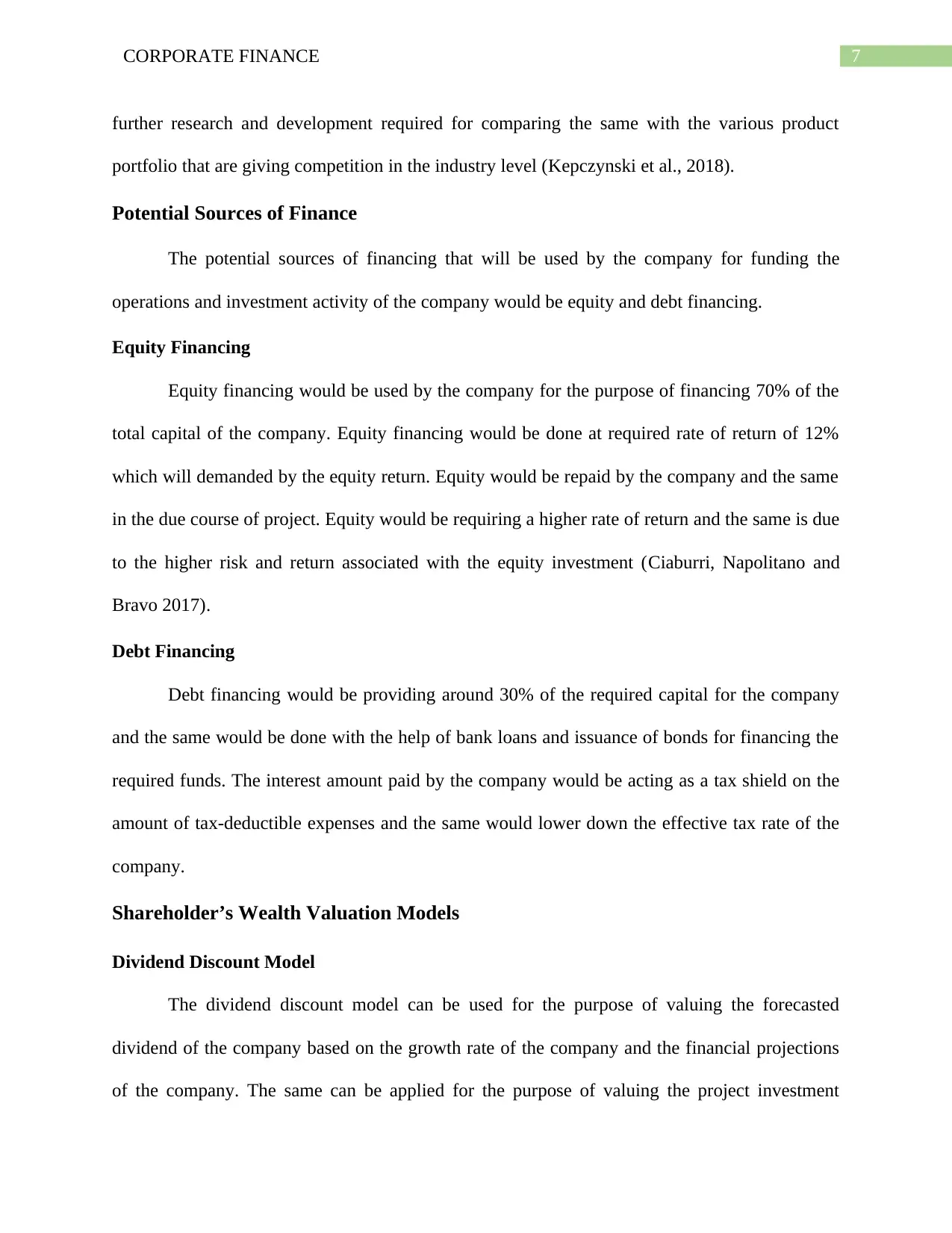
7CORPORATE FINANCE
further research and development required for comparing the same with the various product
portfolio that are giving competition in the industry level (Kepczynski et al., 2018).
Potential Sources of Finance
The potential sources of financing that will be used by the company for funding the
operations and investment activity of the company would be equity and debt financing.
Equity Financing
Equity financing would be used by the company for the purpose of financing 70% of the
total capital of the company. Equity financing would be done at required rate of return of 12%
which will demanded by the equity return. Equity would be repaid by the company and the same
in the due course of project. Equity would be requiring a higher rate of return and the same is due
to the higher risk and return associated with the equity investment (Ciaburri, Napolitano and
Bravo 2017).
Debt Financing
Debt financing would be providing around 30% of the required capital for the company
and the same would be done with the help of bank loans and issuance of bonds for financing the
required funds. The interest amount paid by the company would be acting as a tax shield on the
amount of tax-deductible expenses and the same would lower down the effective tax rate of the
company.
Shareholder’s Wealth Valuation Models
Dividend Discount Model
The dividend discount model can be used for the purpose of valuing the forecasted
dividend of the company based on the growth rate of the company and the financial projections
of the company. The same can be applied for the purpose of valuing the project investment
further research and development required for comparing the same with the various product
portfolio that are giving competition in the industry level (Kepczynski et al., 2018).
Potential Sources of Finance
The potential sources of financing that will be used by the company for funding the
operations and investment activity of the company would be equity and debt financing.
Equity Financing
Equity financing would be used by the company for the purpose of financing 70% of the
total capital of the company. Equity financing would be done at required rate of return of 12%
which will demanded by the equity return. Equity would be repaid by the company and the same
in the due course of project. Equity would be requiring a higher rate of return and the same is due
to the higher risk and return associated with the equity investment (Ciaburri, Napolitano and
Bravo 2017).
Debt Financing
Debt financing would be providing around 30% of the required capital for the company
and the same would be done with the help of bank loans and issuance of bonds for financing the
required funds. The interest amount paid by the company would be acting as a tax shield on the
amount of tax-deductible expenses and the same would lower down the effective tax rate of the
company.
Shareholder’s Wealth Valuation Models
Dividend Discount Model
The dividend discount model can be used for the purpose of valuing the forecasted
dividend of the company based on the growth rate of the company and the financial projections
of the company. The same can be applied for the purpose of valuing the project investment
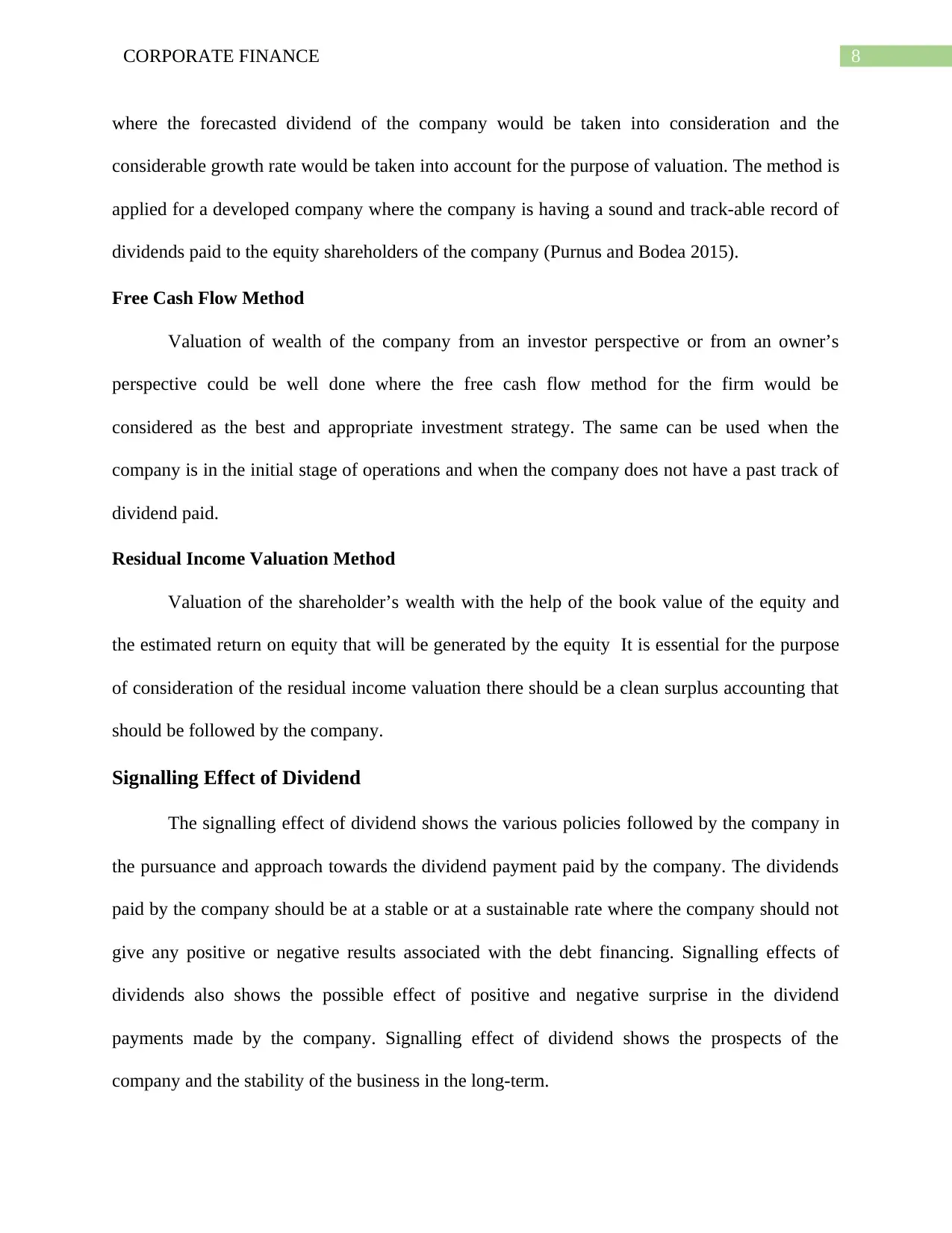
8CORPORATE FINANCE
where the forecasted dividend of the company would be taken into consideration and the
considerable growth rate would be taken into account for the purpose of valuation. The method is
applied for a developed company where the company is having a sound and track-able record of
dividends paid to the equity shareholders of the company (Purnus and Bodea 2015).
Free Cash Flow Method
Valuation of wealth of the company from an investor perspective or from an owner’s
perspective could be well done where the free cash flow method for the firm would be
considered as the best and appropriate investment strategy. The same can be used when the
company is in the initial stage of operations and when the company does not have a past track of
dividend paid.
Residual Income Valuation Method
Valuation of the shareholder’s wealth with the help of the book value of the equity and
the estimated return on equity that will be generated by the equity It is essential for the purpose
of consideration of the residual income valuation there should be a clean surplus accounting that
should be followed by the company.
Signalling Effect of Dividend
The signalling effect of dividend shows the various policies followed by the company in
the pursuance and approach towards the dividend payment paid by the company. The dividends
paid by the company should be at a stable or at a sustainable rate where the company should not
give any positive or negative results associated with the debt financing. Signalling effects of
dividends also shows the possible effect of positive and negative surprise in the dividend
payments made by the company. Signalling effect of dividend shows the prospects of the
company and the stability of the business in the long-term.
where the forecasted dividend of the company would be taken into consideration and the
considerable growth rate would be taken into account for the purpose of valuation. The method is
applied for a developed company where the company is having a sound and track-able record of
dividends paid to the equity shareholders of the company (Purnus and Bodea 2015).
Free Cash Flow Method
Valuation of wealth of the company from an investor perspective or from an owner’s
perspective could be well done where the free cash flow method for the firm would be
considered as the best and appropriate investment strategy. The same can be used when the
company is in the initial stage of operations and when the company does not have a past track of
dividend paid.
Residual Income Valuation Method
Valuation of the shareholder’s wealth with the help of the book value of the equity and
the estimated return on equity that will be generated by the equity It is essential for the purpose
of consideration of the residual income valuation there should be a clean surplus accounting that
should be followed by the company.
Signalling Effect of Dividend
The signalling effect of dividend shows the various policies followed by the company in
the pursuance and approach towards the dividend payment paid by the company. The dividends
paid by the company should be at a stable or at a sustainable rate where the company should not
give any positive or negative results associated with the debt financing. Signalling effects of
dividends also shows the possible effect of positive and negative surprise in the dividend
payments made by the company. Signalling effect of dividend shows the prospects of the
company and the stability of the business in the long-term.
⊘ This is a preview!⊘
Do you want full access?
Subscribe today to unlock all pages.

Trusted by 1+ million students worldwide
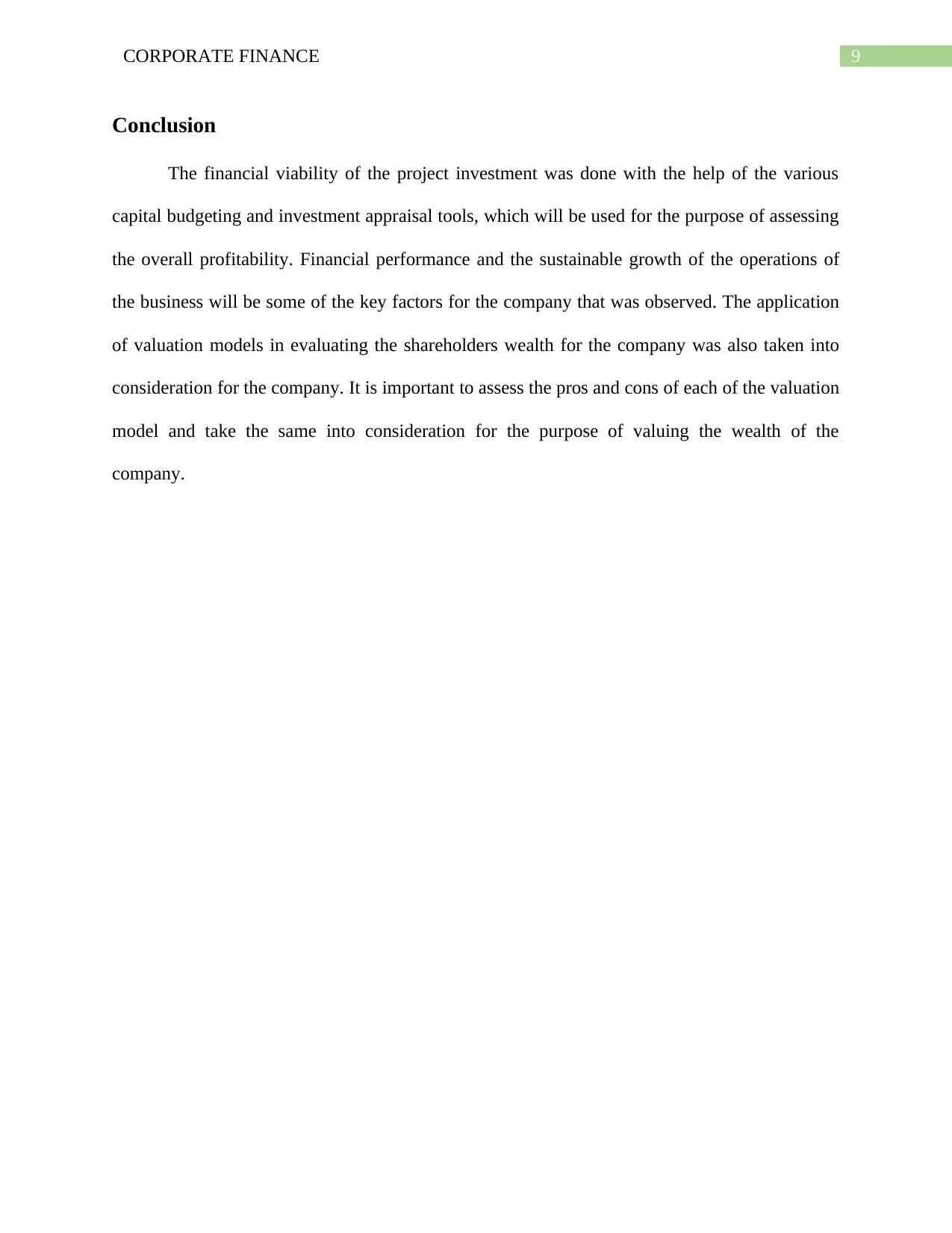
9CORPORATE FINANCE
Conclusion
The financial viability of the project investment was done with the help of the various
capital budgeting and investment appraisal tools, which will be used for the purpose of assessing
the overall profitability. Financial performance and the sustainable growth of the operations of
the business will be some of the key factors for the company that was observed. The application
of valuation models in evaluating the shareholders wealth for the company was also taken into
consideration for the company. It is important to assess the pros and cons of each of the valuation
model and take the same into consideration for the purpose of valuing the wealth of the
company.
Conclusion
The financial viability of the project investment was done with the help of the various
capital budgeting and investment appraisal tools, which will be used for the purpose of assessing
the overall profitability. Financial performance and the sustainable growth of the operations of
the business will be some of the key factors for the company that was observed. The application
of valuation models in evaluating the shareholders wealth for the company was also taken into
consideration for the company. It is important to assess the pros and cons of each of the valuation
model and take the same into consideration for the purpose of valuing the wealth of the
company.
Paraphrase This Document
Need a fresh take? Get an instant paraphrase of this document with our AI Paraphraser
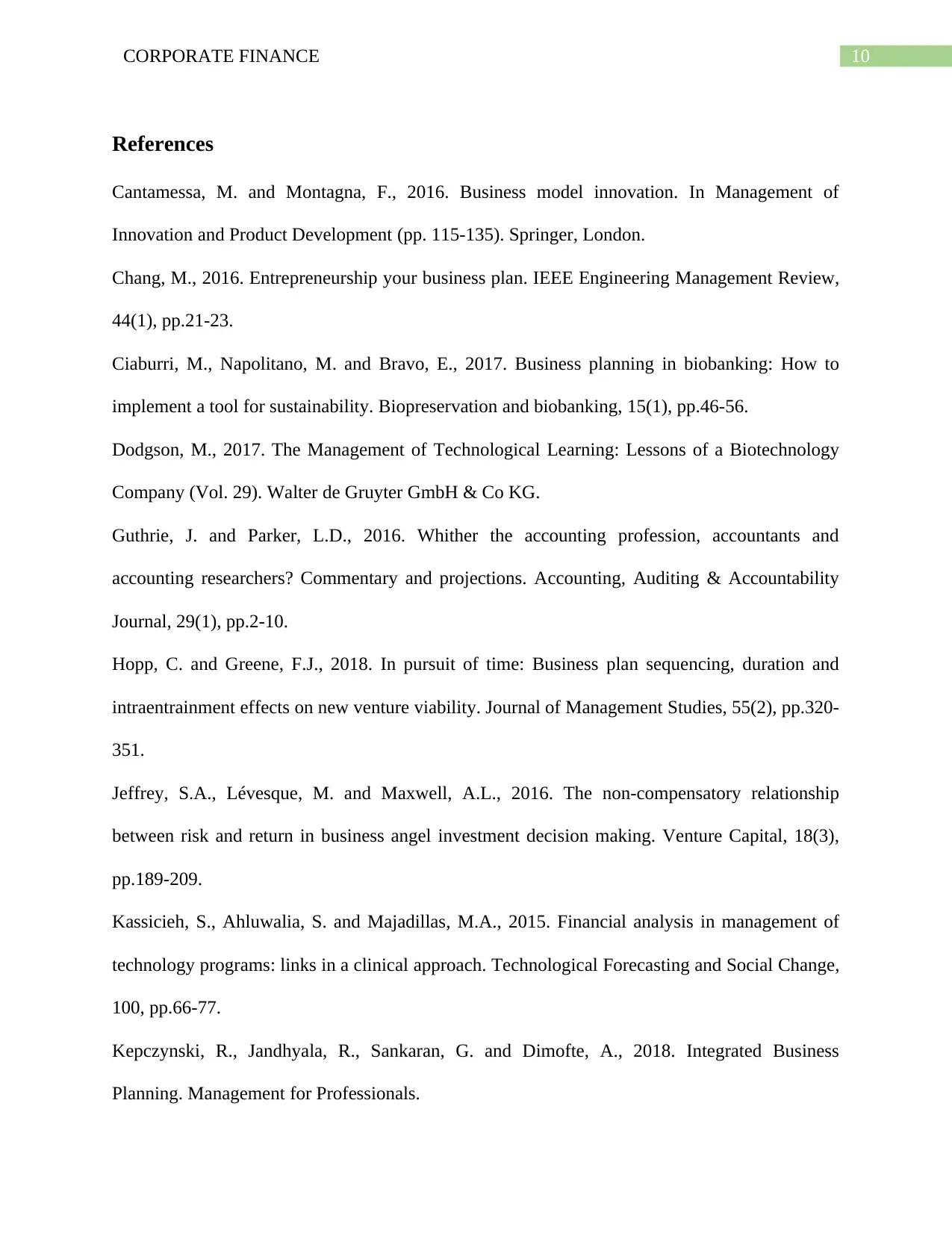
10CORPORATE FINANCE
References
Cantamessa, M. and Montagna, F., 2016. Business model innovation. In Management of
Innovation and Product Development (pp. 115-135). Springer, London.
Chang, M., 2016. Entrepreneurship your business plan. IEEE Engineering Management Review,
44(1), pp.21-23.
Ciaburri, M., Napolitano, M. and Bravo, E., 2017. Business planning in biobanking: How to
implement a tool for sustainability. Biopreservation and biobanking, 15(1), pp.46-56.
Dodgson, M., 2017. The Management of Technological Learning: Lessons of a Biotechnology
Company (Vol. 29). Walter de Gruyter GmbH & Co KG.
Guthrie, J. and Parker, L.D., 2016. Whither the accounting profession, accountants and
accounting researchers? Commentary and projections. Accounting, Auditing & Accountability
Journal, 29(1), pp.2-10.
Hopp, C. and Greene, F.J., 2018. In pursuit of time: Business plan sequencing, duration and
intraentrainment effects on new venture viability. Journal of Management Studies, 55(2), pp.320-
351.
Jeffrey, S.A., Lévesque, M. and Maxwell, A.L., 2016. The non-compensatory relationship
between risk and return in business angel investment decision making. Venture Capital, 18(3),
pp.189-209.
Kassicieh, S., Ahluwalia, S. and Majadillas, M.A., 2015. Financial analysis in management of
technology programs: links in a clinical approach. Technological Forecasting and Social Change,
100, pp.66-77.
Kepczynski, R., Jandhyala, R., Sankaran, G. and Dimofte, A., 2018. Integrated Business
Planning. Management for Professionals.
References
Cantamessa, M. and Montagna, F., 2016. Business model innovation. In Management of
Innovation and Product Development (pp. 115-135). Springer, London.
Chang, M., 2016. Entrepreneurship your business plan. IEEE Engineering Management Review,
44(1), pp.21-23.
Ciaburri, M., Napolitano, M. and Bravo, E., 2017. Business planning in biobanking: How to
implement a tool for sustainability. Biopreservation and biobanking, 15(1), pp.46-56.
Dodgson, M., 2017. The Management of Technological Learning: Lessons of a Biotechnology
Company (Vol. 29). Walter de Gruyter GmbH & Co KG.
Guthrie, J. and Parker, L.D., 2016. Whither the accounting profession, accountants and
accounting researchers? Commentary and projections. Accounting, Auditing & Accountability
Journal, 29(1), pp.2-10.
Hopp, C. and Greene, F.J., 2018. In pursuit of time: Business plan sequencing, duration and
intraentrainment effects on new venture viability. Journal of Management Studies, 55(2), pp.320-
351.
Jeffrey, S.A., Lévesque, M. and Maxwell, A.L., 2016. The non-compensatory relationship
between risk and return in business angel investment decision making. Venture Capital, 18(3),
pp.189-209.
Kassicieh, S., Ahluwalia, S. and Majadillas, M.A., 2015. Financial analysis in management of
technology programs: links in a clinical approach. Technological Forecasting and Social Change,
100, pp.66-77.
Kepczynski, R., Jandhyala, R., Sankaran, G. and Dimofte, A., 2018. Integrated Business
Planning. Management for Professionals.
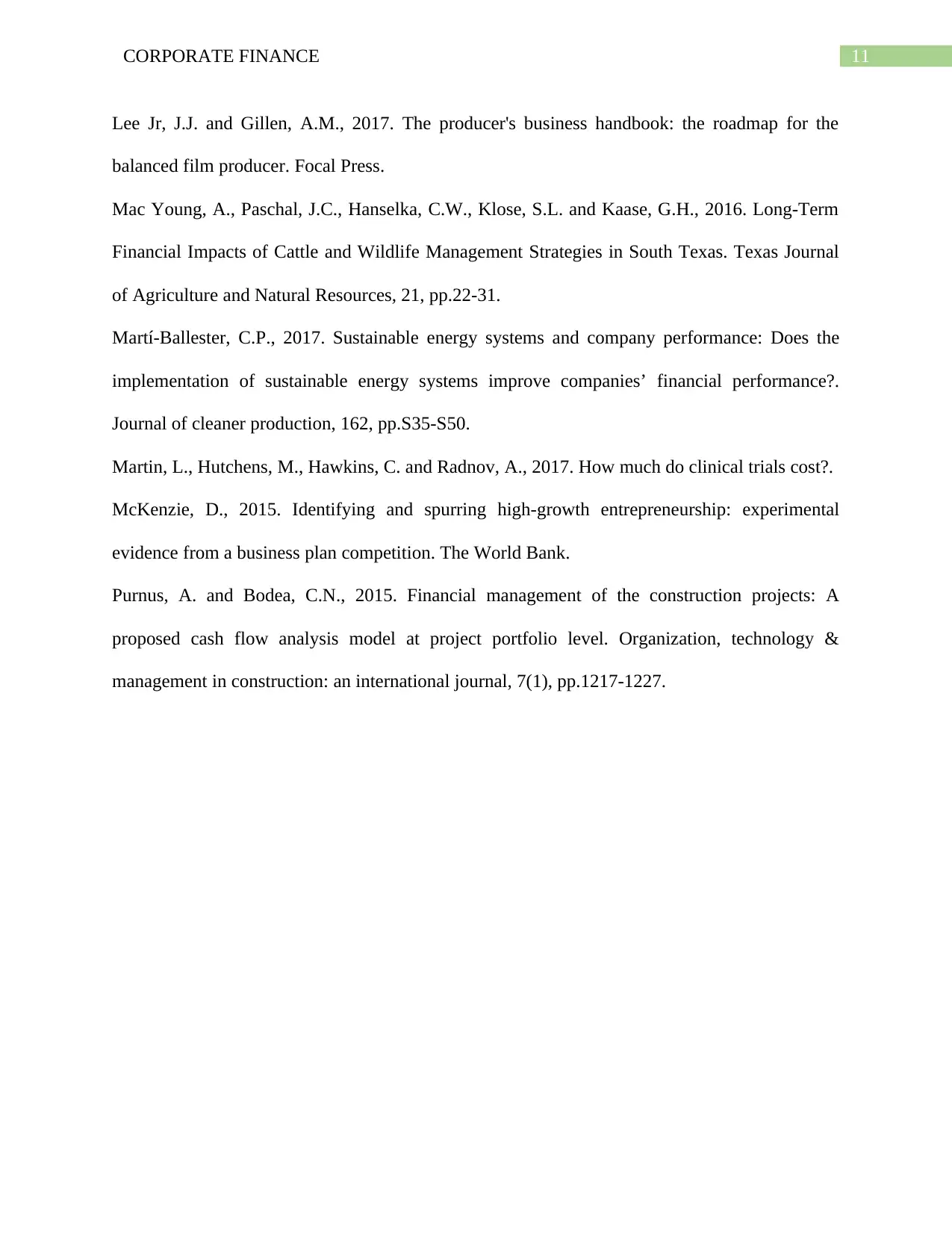
11CORPORATE FINANCE
Lee Jr, J.J. and Gillen, A.M., 2017. The producer's business handbook: the roadmap for the
balanced film producer. Focal Press.
Mac Young, A., Paschal, J.C., Hanselka, C.W., Klose, S.L. and Kaase, G.H., 2016. Long-Term
Financial Impacts of Cattle and Wildlife Management Strategies in South Texas. Texas Journal
of Agriculture and Natural Resources, 21, pp.22-31.
Martí-Ballester, C.P., 2017. Sustainable energy systems and company performance: Does the
implementation of sustainable energy systems improve companies’ financial performance?.
Journal of cleaner production, 162, pp.S35-S50.
Martin, L., Hutchens, M., Hawkins, C. and Radnov, A., 2017. How much do clinical trials cost?.
McKenzie, D., 2015. Identifying and spurring high-growth entrepreneurship: experimental
evidence from a business plan competition. The World Bank.
Purnus, A. and Bodea, C.N., 2015. Financial management of the construction projects: A
proposed cash flow analysis model at project portfolio level. Organization, technology &
management in construction: an international journal, 7(1), pp.1217-1227.
Lee Jr, J.J. and Gillen, A.M., 2017. The producer's business handbook: the roadmap for the
balanced film producer. Focal Press.
Mac Young, A., Paschal, J.C., Hanselka, C.W., Klose, S.L. and Kaase, G.H., 2016. Long-Term
Financial Impacts of Cattle and Wildlife Management Strategies in South Texas. Texas Journal
of Agriculture and Natural Resources, 21, pp.22-31.
Martí-Ballester, C.P., 2017. Sustainable energy systems and company performance: Does the
implementation of sustainable energy systems improve companies’ financial performance?.
Journal of cleaner production, 162, pp.S35-S50.
Martin, L., Hutchens, M., Hawkins, C. and Radnov, A., 2017. How much do clinical trials cost?.
McKenzie, D., 2015. Identifying and spurring high-growth entrepreneurship: experimental
evidence from a business plan competition. The World Bank.
Purnus, A. and Bodea, C.N., 2015. Financial management of the construction projects: A
proposed cash flow analysis model at project portfolio level. Organization, technology &
management in construction: an international journal, 7(1), pp.1217-1227.
⊘ This is a preview!⊘
Do you want full access?
Subscribe today to unlock all pages.

Trusted by 1+ million students worldwide
1 out of 12
Related Documents
Your All-in-One AI-Powered Toolkit for Academic Success.
+13062052269
info@desklib.com
Available 24*7 on WhatsApp / Email
![[object Object]](/_next/static/media/star-bottom.7253800d.svg)
Unlock your academic potential
Copyright © 2020–2025 A2Z Services. All Rights Reserved. Developed and managed by ZUCOL.





